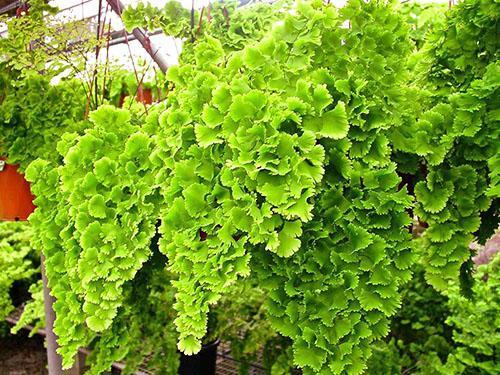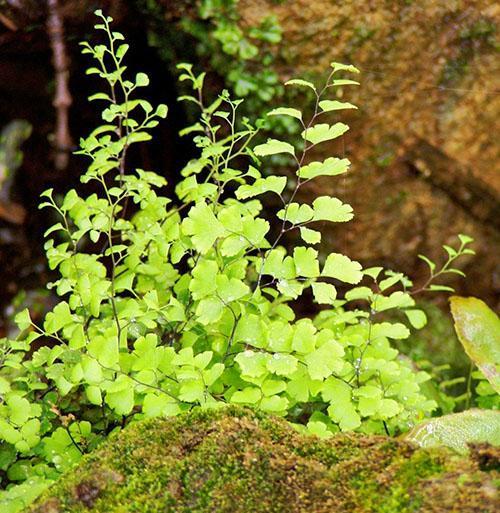Choosing a maidenhair plant for your home and garden
 Ferns are rightfully considered the oldest representatives of the plant kingdom on the planet. Today, these plants are not so common in nature, so all species are of great interest to gardeners and indoor crop lovers.
Ferns are rightfully considered the oldest representatives of the plant kingdom on the planet. Today, these plants are not so common in nature, so all species are of great interest to gardeners and indoor crop lovers.
The maidenhair, uniting about 200 species, are one of the few ferns that easily grow not only in gardens, but also at home, relatively easily tolerating the content in a limited pot, dry atmosphere and constant air temperature.
In nature, however, maidenhair plants prefer to settle on the shores of reservoirs, where they root on small accumulations of humus that has been hammered between stones. In such conditions, the plants do not lack nutrition and moisture, the air is always moist and cool.
At the same time, drops of moisture easily roll off the smooth surface of the frond, and the leaves of the plant always remain dry. This property of the maidenhair and determined the name of the genus, literally translated as "not wet".
Where is the homeland of the maidenhair?

Today, botanists distinguish two natural areas of this genus, which mainly cover the tropical and subtropical regions of both hemispheres. Independent species of adiantum are found in South America, where plants grow and reproduce beautifully on rocky ledges in the Andes.
The second area of distribution of the genus is located in the east of the Asian region. Almost four dozen species have been identified in China and neighboring countries alone, but this does not mean that ferns of this genus cannot be found in other places.
One of the most common and beloved by flower growers adiantum is Adiantum capillus veneris, or Venus of hair, which also lives in our country. Here, maidenhair plants can be found while traveling across the Caucasus and Crimea. Along with the other fern, the maidenhair stopoid, the hair venus easily adapted to the conditions of the local foothills, enduring not tropical cold winters at all.
On the territory of Europe, there are wild-growing adiantums in the Mediterranean, separate populations of plants have settled in the northern regions of the African continent, areas in the Caucasus and in the mountainous regions of Central Asia.
There are maidenhair in Australia, and the most northerly representatives of the genus live on the coast of Britain, where humid air and rocky shelters help to survive the winter.
Maidenhair: characteristics and description of the plant
 Despite the variety of species, united under the general name "maidenhair", plants have a lot of common features and properties.
Despite the variety of species, united under the general name "maidenhair", plants have a lot of common features and properties.
Fronds or fern leaves in most maidenhair varieties, dissected or feathery, sometimes asymmetrical. At the same time, foliage can be of different sizes and colors, the structure of the smallest leaves and the degree of branching differ. At the same time, the spore maturation zones in all ferns are located on the back of the frond, and the leaf shafts are very thin but strong.
All perennial herbaceous plants of the maidenhair do not exceed half a meter in height, large leaves have a drooping appearance and form a beautiful openwork canopy.To live on rocky slopes, maidenhair plants are helped by multiple rhizoids extending from the main powerful rhizome, easily penetrating between individual stones and using any method to keep on the surface and obtain nutrition.
Energy plant maidenhair
 At first glance at the maidenhair, it may seem that the plant is extremely delicate and fragile. But with long-term cultivation, it turns out that this spectacular fern not only has a powerful vitality itself, but also carries a bright positive energy.
At first glance at the maidenhair, it may seem that the plant is extremely delicate and fragile. But with long-term cultivation, it turns out that this spectacular fern not only has a powerful vitality itself, but also carries a bright positive energy.
Maidenhair plants bring an atmosphere of love and understanding to the houses where they grow, the flower is especially favorable to women. Fragile, thin, like the hair of a young girl, the leaf shafts successfully withstand all the vicissitudes, and give the same stamina to their owners. It is worth noting that the maidenhair is not poisonous, and therefore there is a place for it in any of the rooms, be it a living room, an office or a nursery.
And in regions with milder climates, where winter temperatures allow fern to relive this time, the culture is actively grown in the gardens. It is the plant's adaptability to a variety of habitat conditions that is the most important characteristic of the maidenhair, which is appreciated by flower growers all over the world. But the beneficial properties of the maidenhair are not limited to this.
How is maidenhair useful?
 The beneficial properties of the maidenhair were studied and described by ancient scientists. Pliny the Elder, committed to the theory and treatment of the like, wrote about the benefits of fern grass for strengthening hair. And in some regions of Transcaucasia, maidenhair is still used in herbal preparations to activate hair growth.
The beneficial properties of the maidenhair were studied and described by ancient scientists. Pliny the Elder, committed to the theory and treatment of the like, wrote about the benefits of fern grass for strengthening hair. And in some regions of Transcaucasia, maidenhair is still used in herbal preparations to activate hair growth.
Medicinal infusions and fern teas have also been known since ancient times. But what is the use of maidenhair today, when scientists can find out to the smallest details the composition and properties of plant raw materials?
In the pharmacopoeias of European countries, the maidenhair plant was included on the basis of confirmation of its usefulness:
- with inflammatory diseases of the respiratory system;
- with parasitic invasions;
- with heat;
- if you need to take mild sedatives.
Fern greens and rhizomes have the ability to relieve the symptoms of alcohol and chemical poisoning.
 In Southeast Asia, as well as in Europe and South America, the maidenhair herb has been used in the composition of the drug for fever since ancient times. The leaves, crushed to a homogeneous state, were used as an ointment for tumors, the decoction relieved stomach and intestinal pains. Today, most of the uses of the plant are fully or partially approved by official medicine.
In Southeast Asia, as well as in Europe and South America, the maidenhair herb has been used in the composition of the drug for fever since ancient times. The leaves, crushed to a homogeneous state, were used as an ointment for tumors, the decoction relieved stomach and intestinal pains. Today, most of the uses of the plant are fully or partially approved by official medicine.
The extract obtained from the plant of adiantum Venus hair exhibits antimicrobial activity, and the drug is able to cope with such formidable microorganisms as candida, E. coli and Proteus, Pseudomonas aeruginosa and staphylococcus. Due to the presence of a specific essential oil, adiantum is useful in the fight against aspergillus of various varieties and streptococci.
In addition, active flavonoids and glucosides, kaempferol and quercetin sulfates, lipids, steroids and other compounds that have a beneficial therapeutic effect on the body are found in plant fronds.